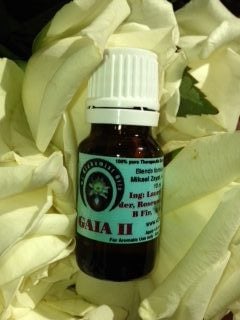-
 Cedarwood, Atlas, Cedrus Atlantica - United States 100% pure and natural oil, distilled from the wings of the tree. Excellent for balancing fluids in the body especially fluid retention. It is a powerful essential oil, astringent and tonic, to be used diluted in a suitable vegetable oil (jojoba, coconut etc) Ideal when blended with white pine and black spruce.
Cedarwood, Atlas, Cedrus Atlantica - United States 100% pure and natural oil, distilled from the wings of the tree. Excellent for balancing fluids in the body especially fluid retention. It is a powerful essential oil, astringent and tonic, to be used diluted in a suitable vegetable oil (jojoba, coconut etc) Ideal when blended with white pine and black spruce. -

Gaia II - Lavender, Rosewood, Lavender, Juniper, Arborvitae, Balsam Fir
To spiritually portect and love the earth; meditation for Mother Earth. It also gives you the freedom to speak the truth. I want to sing/praise. Rub 3 to 4 drops in your hands, inhale, then brush your aura and touch the earth. Safety- keep away from children, air, heat and light. Disclaimer: These statements have not been evaluated by the Food and Drug Administration. This product is not intended to diagnose, treat, cure, or prevent any disease or medical condition. The information provided is general and should not be taken as medical advice. Please consult your doctor, especially if being used during pregnancy, before using this product. -


White Ray: Lavendin, White Pine, White Spruce, Canadian Tsuga, Balsam Fir, Neroli, Angelica,
It works well for people already on their path. But Lana does not advise this blend for people depressed as Beams of Light may hit shadow aspects of the personality or repressed memories. Just smell or sniff it. That is enough. -

Tara: Eucalyptus, Goldenrod, Palmarosa, Hyssop, Myrrh, Frankincense
Goddess of Peace and Abundance Goddess Tara is probably the oldest goddess who is still worshipped extensively in modern times. Tara originated as a Hindu goddess, the Mother Creator, representing the eternal life force that fuels all life. There are many embodiments of Tara, but the best known are the White Tara and the Green Tara. The peaceful, compassionate White Tara gently protects and brings long life and peace. The more dynamic goddess, Green Tara is the "Mother Earth", and a fierce goddess who overcomes obstacles, and saves us from physical and spiritual danger. In Sanskrit, the name Tara means Star, but she was also called She Who Brings Forth Life, The Great Compassionate Mother, and The Embodiment of Wisdom, and the Great Protectress. Adopted by Buddhism, she became the most widely revered deity in the Tibetan pantheon. In Buddhist tradition, Tara is actually much greater than a goddess -- she is a female Buddha, an enlightened one was has attained the highest wisdom, capability and compassion...one who can take human form and who remains in oneness with every living thing. In the legends of Tibet where the worship of the Goddess Tara is still practiced in the Buddhist tradition, it is told that the goddess Tara is the feminine counterpart of the Avalokitesvara, the Buddha who is reincarnated as the Dalai Lama. Goddess Tara in her many incarnations has many gifts to share with contemporary women. Tara embodies the feminine strengths of great caring and compassion, the ability to endure stressful and even terrifying moments, the acts of creation, and the source of sustenance and protection. Refugees fleeing the horrors of the occupation of Tibet by the Chinese armies recounted numerous stories of the Green Tara that protected them during their torture and guided their flight to freedom. In other of her forms, such as the White Tara, she embodied inner peace and spiritual acceptance. She symbolizes purity and is thought to be part of every good and virtuous woman. To bring peace and harmony in relationships for couples and family members, apply 2 or 3 drops under the feet around toes. Personal experience: The oil goes to the stomach meridian (dealing with inner chatting & excessive thinking) It helps you go through life with open eyes. It works as a pair with MARY. It will open you to guidance. Apply drops on forehead on either side of the 3rd eye and the tip of the brow. LT



